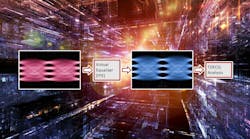Dreamstime_agsandrew_32581249
Members Only Content
TDECQ: Understanding the Theory Behind the Key Metric for PAM4 Optical Transmitters (Download)
March 1, 2024
Next-generation communications systems generally strive to achieve higher capacities than previous generations. Physical limitations of channel bandwidths led to the use of four-level amplitude modulation (PAM4) schemes rather than non-return-to-zero (NRZ) modulation for 400-Gb/s systems developed in the IEEE 802.3bs standard.
Bit-error-ratios (BER), typically better than 1e-12, could not be economically achieved using PAM4, thus requiring the use of forward error correction (FEC) to achieve the required frame-loss ratio for an Ethernet system. The use of FEC and PAM4 led to significant changes in how an optical transmitter is specified and tested.
Comments
Comments
